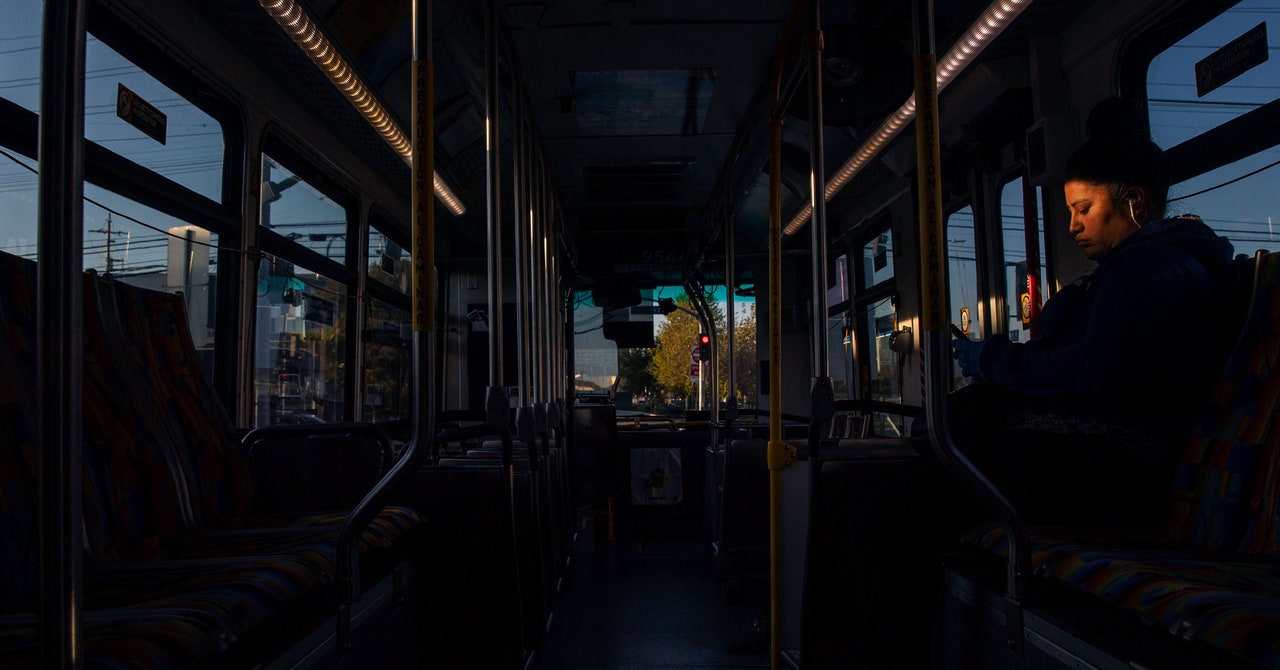This story originally appeared on Undark and is part of the Climate Desk collaboration.
During the ongoing Covid-19 crisis, some city buses and trains have run empty, while others have been packed. In Los Angeles, for instance, daily ridership on the LA Metro has dropped from about 1.2 million to around 400,000 on weekdays. Detroit’s number 17 bus and some lines in New York City, on the other hand, have run at a potentially dangerous capacity.
To address this and other issues during the pandemic, some cities—including LA, Abu Dhabi, Berlin, and Palma de Mallorca, Spain—are turning to on-demand programs called microtransit. Microtransit operates like Uber or Lyft, but in this case the digital routing and ride-hailing platforms are created by tech companies for transit agencies. According to Jerome Mayaud, lead data scientist with microtransit company Spare Labs, cities can use the platforms with public transit to fill specific niches and to offer rides that can be more affordable than solely private operations.
“Imagine Uber and a city bus had a baby,” Mayaud said.
Since the start of the pandemic, cities have turned to microtransit to offer essential rides, like moving seniors to pharmacies or nurses to hospitals. Proponents of microtransit say the technology behind these apps could be used to combat Covid-19 in other ways. For instance, the apps could help track the spread of infection and alert riders if they shared a ride with someone who later tested positive, a tactic called contact tracing.
Experts are mixed on the proposals. Some say contact tracing, for instance, poses privacy issues, and that there will be technical challenges in implementing other strategies through the platforms. Others say microtransit could play a useful role as city streets begin to return to normal.
Microtransit predates the pandemic, and it takes many different forms depending on a city’s needs or the companies involved. Cities partnered with Via Transportation may use their own shuttles, vans, or public buses for the service, or have Via source the vehicles for them, while those partnered with Spare usually repurpose public vans and buses for the service. Transit agencies determine their own fare—rides in LA using Via are currently free, while in Lincoln, Nebraska, where a bus ride is normally $1.75, microtransit service is $5. Meanwhile, the Utah Transit Authority set its microtransit rides at $2.50, the same as a bus ride. Rides can either go directly from, say, a person’s house to their job, or to and from locations chosen by the transit agency.
Some cities, like Lincoln, Nebraska, were considering on-demand transit and quickly adopted it when the disease struck. Others already had systems in place and adapted them in response to it. LA Metro, for instance, through a pilot project with Via, provided rides to three transit stations prior to the Covid-19 outbreak. The agency adapted the program and began offering direct rides to and from essential services and jobs—to help out, as it had to reduce its service levels during the pandemic, said LA Metro’s chief innovation officer, Joshua Schank. The agency has plans to release an additional microtransit project through a $29 million pilot with ride-sharing company RideCo, he added.
While microtransit may prove useful, it’s unlikely that it—or any other single method for that matter—will alone adequately reduce the spread of Covid-19 on public transit, said Joseph Allen, an assistant professor of exposure assessment science at Harvard University.
Some transit systems, for instance, are using low-tech approaches to curb the disease. TransLink in Vancouver, British Columbia, began drawing 6-foot marks at bus stops to show the recommended distance between passengers. Others are amping up cleaning schedules or giving masks to passengers. And digital modeling performed by Allen and colleagues suggests that the viral load in a car could be significantly reduced by cracking the window a few inches. But combining tactics, including regular hand-washing and universal mask usage, is more effective, he said.
“I think we’re going to have to get really clever as a society with solutions,” Allen added, and microtransit “fits right in there.”
Lockdowns and social distancing have been tricky for transit agencies, said Sharon Feigon, executive director of the Shared-Use Mobility Center, a public-interest nonprofit organization that advocates for reducing private vehicle use and offering more options, including escooters, bike-sharing, and microtransit.
On one hand, transit agencies provide a vital service, particularly during the pandemic. But on the other, in light of Covid-19, low ridership and increased safety methods are straining transit agency budgets. Many agencies have had to reduce subway and bus frequency, and microtransit could be used to fill in some of these service gaps, particularly at odd hours, Feigon said.
Microtran

